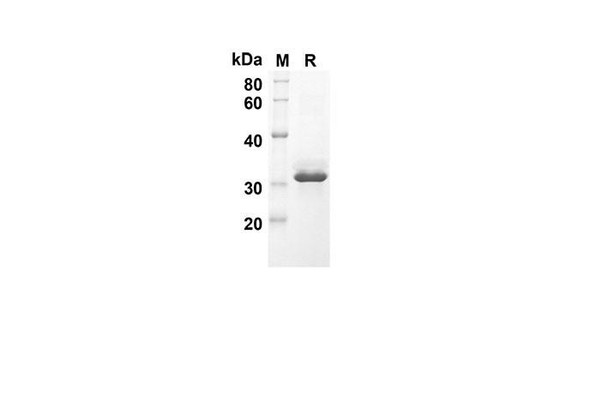Caspase-8 (Cysteine-aspartic acid protease 8/Casp8a, also named MCH5, FLICA and MACH alpha 1) is a 28 kDa member of the peptidase C14A family of enzymes. It is widely expressed and is considered an initiating caspase for the apoptotic cascade. Caspase-8 acts on a wide variety of substrates, including procaspases-3, 4, 6, 7, 9 and 10, c-FLIPL and procaspase-8 itself. Human procaspase-8a is a 54-56 kDa, 479 amino acid (aa) protein. It contains two N-terminal death domains (aa 1-177), followed by a catalytic site that utilizes His317Gly318 plus Cys360. Normally, it is an inactive, cytosolic monomer. But following death-domain (DD) containing receptor oligomerization, Caspase-8 is recruited to the death-inducing signaling complex (DISC) that forms around the death domains of the oligomerized receptor. FADD/CAP-1 is recruited first, followed by procaspase-8/CAP-4 and, possibly, c-FLIPL and procaspase-10. The recruitment, or concentration, of procaspase-8 induces homodimerization. This act alone is sufficient for activation. However, the activity level is modest at best, and appears to be directed towards either itself, or c-FLIPL, which is known to form a functional heterodimer with procaspase-8. When directed towards itself, autocleavage occurs first between Asp374Ser375, generating a 43 kDa (p43) N-terminal (aa 1-374) and an 11 kDa C-terminal (aa 375-479) fragment. The C-terminus is further cleaved between Asp384Leu385 to generate a mature p10 subunit (aa 385-479). The p43 subunit is next cleaved twice, once between Asp216Ser217, and again between Asp210Ser211 to generate a 26 kDa DD-containing prodomain (aa 1-210) with an additional 18 kDa mature p18 subunit (aa 217-374). p18 and p10 noncovalently associate to form a 28 kDa heterodimer, which subsequently associates with another p18:p10 heterodimer to form an active, mature Caspase-8 molecule. This leaves the DISC to act on downstream apoptotic procaspases. In the event procaspase-8 comes to the DISC complexed with c-FLIPL, c-FLIPL will be cleaved by procaspase-8, generating a p43 fragment that is analogous to the Caspase-8 p43 subunit. This fragment, however, appears not to be an intermediate in a proteolytic cascade. Rather, it serves as a functional subunit, interacting with TRAF2 and activating NF kappa B. This may account for many of the nonapoptotic activities associated with Caspase-8. Mature Human and Mouse Caspase-8a heterodimers are 73% aa identical.






